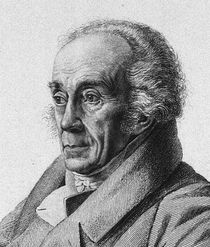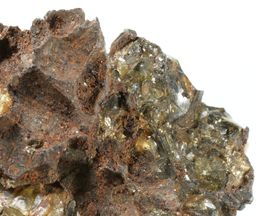|
Family background
Education and career
Blumenbach and Göttingen
Academy of Sciences
Scientific collections
Biographical data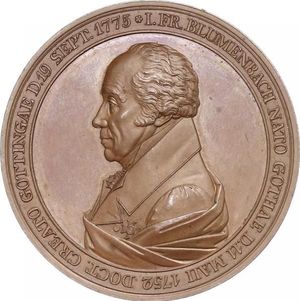
Bronze medal celebrating J. F. Blumenbach’s doctoral jubilee in 1825, with his portrait by Heinrich Gube. Bronze. Private collection. Further information. |
|
Biographical sources and literature on Blumenbach
|
| Personnel file in the University Archive Göttingen (digitised) |
| The University Archive Göttingen (UAG) holds documents relating to Blumenbach’s academic career, including Blumenbach’s personnel file, UAG Kur. 4932. The digital copy of a security film is available online: digitised version by Archivinformationssystems Niedersachsen und Bremen. |
| Inventory overview of the University Archive: Selle, Götz von (Bearb.): „Kurzgefaßtes Repertorium des Universitäts-Archivs zu Göttingen“. In: Arnim, Max: Corpus Academicum Gottingense. Göttingen : Vandenhoeck und Ruprecht, 1930, S. 333–346; digitised version. |
| There are three autobiographical texts by Blumenbach: |
| Handwritten Latin CV, on the occasion of the conferral of the doctorate (Göttingen, Universitätsarchiv, Medizinische Fakultät, Dekanats- und Promotionsvorgänge und -urkunden für das Jahr 1775). First published in Baldinger, Ernst Gottfried: Tertio indicit octo candidatis doctissimis gradum doctoris medicinae contulisse ordinem medicorum. Göttingen: Dieterich, 1775, p. 29–33 (with concluding remarks by Baldinger about the doctoral examination procedure; digitised version); annotated edition in Dougherty, Frank William Peter: The correspondence of Johann Friedrich Blumenbach. Rev., augm. and ed. by Norbert Klatt. Band 1 (1773–1782). Göttingen: Klatt, 2006 (Brosamen zur Blumenbach-Forschung; 2), p. 27–33. – The text informs about Blumenbach’s family background and his academic teachers at Jena and Göttingen. |
| Biographical sketch for the Allgemeine geographischen Ephemeriden (letter to Friedrich Justin Bertuch, 28 Februar 1810; Weimar, Goethe- und Schiller-Archiv, GSA, Nachlass Bertuch 06/189, Nr. 20). Printed in Allgemeine geographische Ephemeriden Bd. 32, 2. Stück (Juni 1810), p. 214–217: „Einige biographische Notizen zu Hrn. Hofraths Blumenbach in Göttingen Portrait (Auszug eines Schreibens an d. H.)“; digitised version. |
| A short depiction by Blumenbach about his education until 1778, when he was appointed professor at Göttingen, is published in Marx, Karl Friedrich Heinrich: Zum Andenken an Johann Friedrich Blumenbach: eine Gedächtniss-Rede gehalten in der Sitzung der Königlichen Societät der Wissenschaften den 8. Februar 1840. Göttingen : Druck und Verlag der Dieterichschen Buchhandlung, 1840, p. 4–6; digitised version. |
There is an overview of Blumenbach’s genealogy from 1924:
„Johann Friedrich Blumenbachs Nachkommen, zusammengestellt von Dr. Friedrich Bonhoff. Hamburg 1924“ (Johann Friedrich Blumenbach’s descendants, compiled by Dr Friedrich Bonhoff. Hamburg 1924). Printed single sheet with family tree. A copy can be found in the manuscript collection of the Götingen State and University Library, portrait collection, folder “Blumenbach, Johann Friedrich” (digital copy). The author of the family tree, Friedrich Bonhoff (1883–1966), was married to a descendant of J. F. Blumenbach. |
|
|
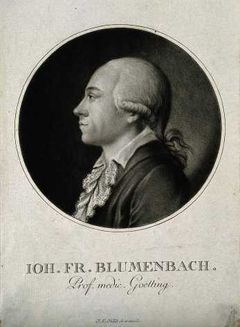
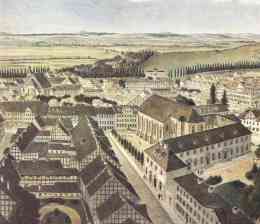
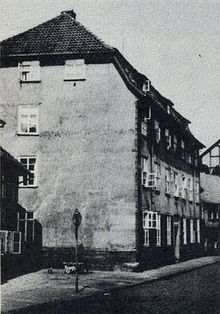 Blumenbach’s home in Göttingen. Historical photograph from D. Koch: Das Göttinger Honoratiorentum vom 17. bis zur Mitte des 19. Jahrhunderts. Göttingen: Vandenhoeck and Ruprecht, 1958, table VIII. The Göttingen naturalist Johann Christian Polycarp Erxleben (1744–1777) lived in this house since 1774. Blumenbach moved into this house in 1784 and bought it in 1816. The present-day name of the street is “Neustadt.” The historical buildings of this part of the town, including Blumenbach’s house, were demolished around 1970.
Blumenbach’s home in Göttingen. Historical photograph from D. Koch: Das Göttinger Honoratiorentum vom 17. bis zur Mitte des 19. Jahrhunderts. Göttingen: Vandenhoeck and Ruprecht, 1958, table VIII. The Göttingen naturalist Johann Christian Polycarp Erxleben (1744–1777) lived in this house since 1774. Blumenbach moved into this house in 1784 and bought it in 1816. The present-day name of the street is “Neustadt.” The historical buildings of this part of the town, including Blumenbach’s house, were demolished around 1970.